-
Superposition cannot be used to solve for circuit values using Ohm 's Law in circuits having more than one connected voltage source.
Select one:
True
False
The correct answer is 'False'.
-
When solving for values in circuits having more than one voltage source, all voltage
sources but one must be ? when calculating the Superposition Theorem.
a.connected
b.opened
c.shorted
d.tied to ground
The correct answer is: shorted
-
Using the principle of superposition, proper calculation of currents from each ? can be
found for individual components to be used for determining final values.
a.parallel source
b.power source
c.resistor
d.series branch
The correct answer is: power source
-
Using superposition, the current must be found for each ? .
a.inductor
b.parallel resistor
c.power source
d.series resistor
The correct answer is: power source
-
The total current using the principle of superposition will be the algebraic sum of the
individual currents.
Select one:
True
False
The correct answer is 'True'.
-
Which of the following steps are involved in applying the principle of superposition?
a.Assume a direction of current flow through the load.
b.Calculate the current flow for the selected source.
c.Repeat this procedure for each power source in the circuit; determine the amount of
current and the direction of current flow through the load.
d.Select one power source and replace all the other power sources in the circuit with a
short circuit.
e.All of the above
The correct answer is: All of the above
-
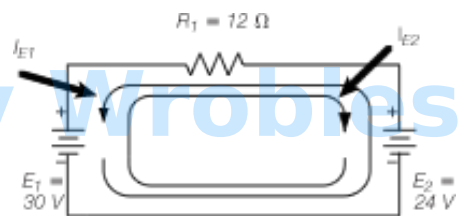
Find the total current through R in the circuit using the principle of superposition.
Calculate to one decimal place.
The correct answer is: 0.5 A
-
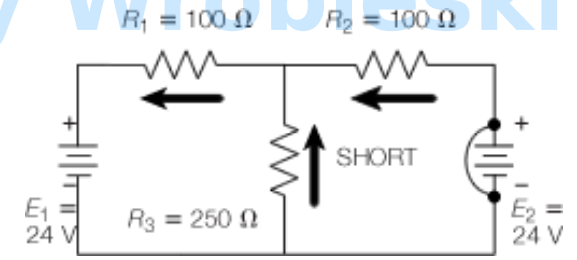
The circuit represents the circuit and direction of current flow to solve for the effects of
voltage source E .
Select one:
True
False
The correct answer is 'False'.
-
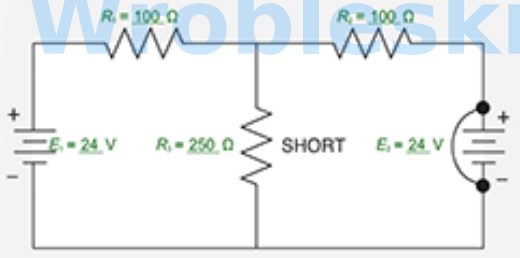
Given the circuit and parameters shown, solve for the absolute value (input a positive number) and for personal reference be sure to note polarity of the following:
(Note: The calculated values and polarities from this question will be used to answer other questions. Assume polarity of current flow from source E to be positive.)
IR1 = ? mA
IR2 = ? mA
IR3 = ? mA
The correct answer is: 140 mA
The correct answer is: 100 mA
The correct answer is: 40 mA
-
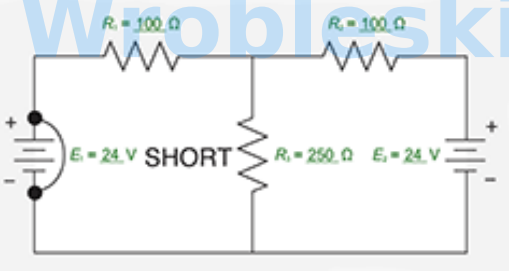
Given the circuit and parameters shown, solve for the absolute value (input a positive number) and for personal reference, be sure to note polarity of the following:
(Note: The calculated values and polarities from this question will be used to answer
other questions. Assume polarity of current flow from source E to be positive.)
IR1 = ? mA
IR2 = ? mA
IR3 = ? mA
The correct answer is: 100 mA
The correct answer is: 140 mA
The correct answer is: 40 mA
-
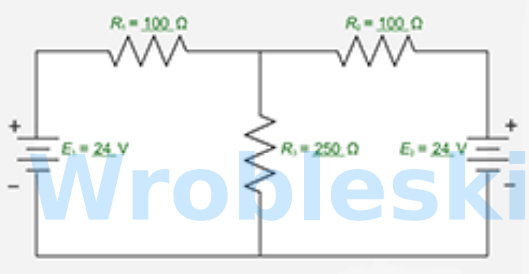
Using the polarities and values computed in previous questions, and referring to the circuit shown, calculate the values and polarity of the following:
(Note: When recording final answers, make sure to input the negative sign when necessary and assume polarity of current flow from source E to be positive.)
IR1 = ? mA
ER1 = ? V
IR2 = ? mA
ER2 = ? V
IR3 = ? mA
ER3 = ? V
The correct answer is: 40 mA
The correct answer is: 4 V
The correct answer is: -40 mA
The correct answer is: -4 V
The correct answer is: 80 mA
The correct answer is: 20 V
-
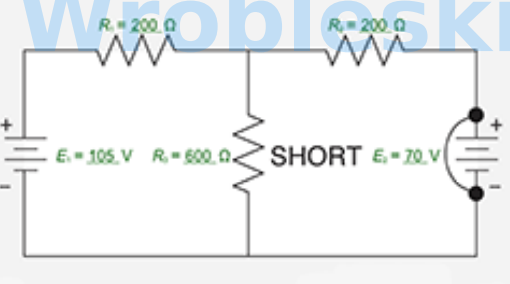
Given the circuit and parameters shown, solve for the absolute value (input a positive number) and for personal reference be sure to note polarity of the following:
(Note: The calculated values and polarities from this question will be used to answer other questions. Assume polarity of current flow from source E to be positive.)
IR1 = ? mA
IR2 = ? mA
IR3 = ? mA
The correct answer is: 300 mA
The correct answer is: 225 mA
The correct answer is: 75 mA
-
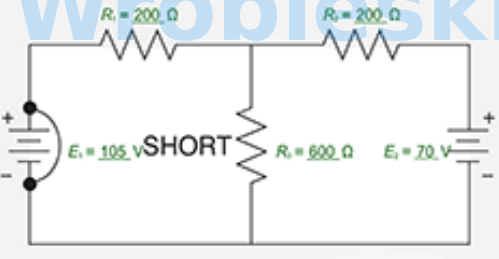
Given the circuit and parameters shown, solve for the absolute value (input a positive
number) and for personal reference be sure to note polarity of the following:
(Note: The calculated values and polarities from this question will be used to answer other questions. Assume polarity of current flow from source E to be positive.)
IR1 = ? mA
IR2 = ? mA
IR3 = ? mA
The correct answer is: 150 mA
The correct answer is: 200 mA
The correct answer is: 50 mA
-
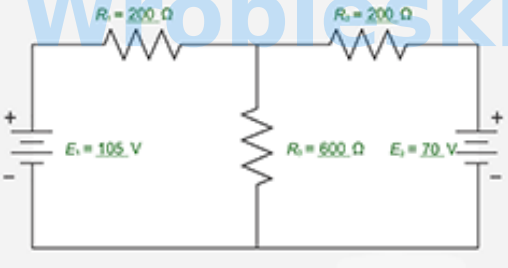
Using the polarities and values computed in previous questions and referring to the
circuit shown, calculate the values and polarity of the following:
(Note: When recording final answers, make sure to input the negative sign when necessary and assume polarity of current flow from source E to be positive.)
IR1 = ? mA
IR2 = ? mA
IR3 = ? mA
The correct answer is: 150 mA
The correct answer is: 25 mA
The correct answer is: 125 mA
-
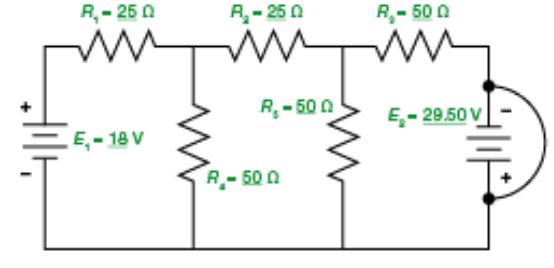
Given the circuit and parameters shown, solve for the value of I with source E shorted.
(Note: The calculated value and polarity from this question will be used to answer other
questions.)
IR4 = ? mA
The correct answer is: 180
-
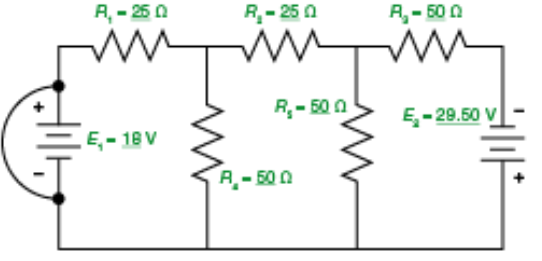
Given the circuit and parameters shown, solve for the value of I with source E shorted.
(Note: The calculated value and polarity from this question will be used to answer other questions.)
IR4 = ? mA
The correct answer is: 73.75
-
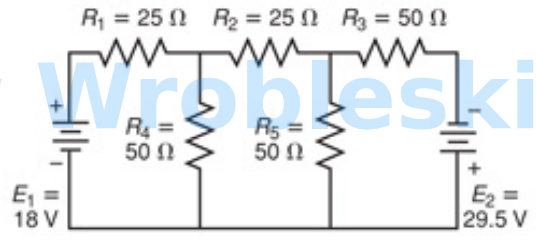
Given the previously calculated currents, find the resultant current for R . (Calculate to three decimal places.)
The correct answer is: 0.106 A
-
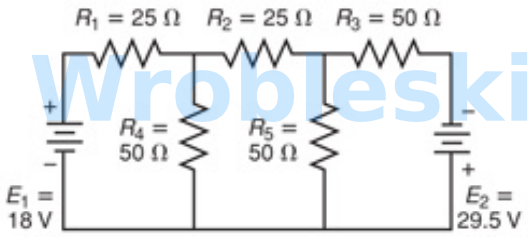
What is the voltage across R when all voltage sources are considered? Calculate to one decimal place.
The correct answer is: 5.3 V


